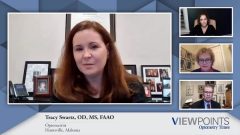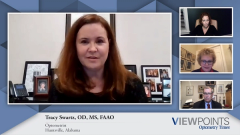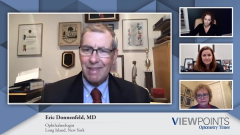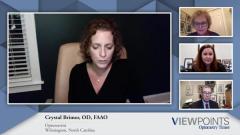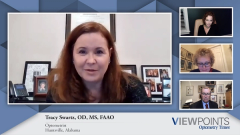
Novel agents in the pipeline for DED
Episodes in this series

Marguerite McDonald, MD: Tracy, tell us about 3 more agents in the pipeline.
Tracy Swartz, OD, MS, FAAO: The first one I’m going to talk about is tanfanercept. This is a tumor necrosis factor receptor 1 fragment that targets pro-inflammatory cytokines to reduce inflammation. This is a new biomedicine that inhibits the tumor necrosis factor activity, so that’s going to modulate the inflammation in the body and hopefully prevent corneal damage. In September 2019, they finished their phase 2 clinical trial in China, and then they proceeded with the phase 2 and now phase 3. According to the manufacturer, they’re going to be presenting data at the ophthalmology meeting in November.
Eric Donnenfeld, MD: I will be presenting that paper, and it’s very exciting. What’s really exciting about this is they found a biomarker in looking at these patients, and if a patient is positive for the biomarker, there’s an exponential increase in activity. For the first time, you have a patient who can be given a biomarker test, and if the biomarker comes back positive, you’re fairly certain that the patient is going to have a positive response to therapy. If the patient is not positive for the biomarker, then you shouldn’t prescribe the medicine. It’s going to be selective therapy based on patients who have the DNA profile to manage this disease.
Marguerite McDonald, MD: Wow, terrific. Go ahead, Tracy.
Tracy Swartz, OD, MS, FAAO: The second one I’m going to talk about is reproxalap. That is a new inflammatory mediator that inhibits reactive aldehyde species [RASP]. Reactive aldehyde species, or RASP, are reactive molecules that covalently bind to cellular biomolecules, disrupting their function and activating pro-inflammatory mediators, which increase inflammation. If we bind the free aldehydes, we can diminish the RASP levels, which would then improve ocular inflammation. That’s the mechanism of action. These are also in phase 2 clinical trials, primarily in allergy with allergic conjunctivitis, and they also are saying that they’re going to present data at the coming academy meeting. The typical concentrations initially were 0.25% and 0.5%, but they both had about the same improvement. So now they’re just going to go with the 0.25% in a phase 3 INVIGORATE trial. We’re hoping that they will get results in the first half of 2021 from that phase 3 trial.
Then the last one I’m going to talk about is the one that I’m most excited about. NOVO3 is 100% perfluorohexyloctane, which stabilizes the lipid layer to protect the tear film for extended periods and has the ability to penetrate the meibomian glands. This is the first drug that uses a water-free technology, which is designed to prevent excessive tear evaporation and restore the tear film balance. The reason I’m so excited is this has the potential to penetrate the meibomian glands and dissolve the thickened meibum, which can directly improve meibomian gland function. In the SEECASE-1 trial, they had both subjective and objective improvements in dry eye disease associated with meibomian gland dysfunction, so now they’ve proceeded with the SEECASE-2 trial, and we’re hoping for an NDA [new drug application] submission in 2021. I think one thing that’s interesting about this as well is the carrier, which is called EyeSol, is a water-free technology that is used as a carrier for ophthalmic products. This is a carrier that increases the residual time that that medication is available on the ocular surface, and they’re reporting excellent tolerability and safety. What’s interesting is the drop size is small. It’s 10 μL, which I think would be great for toxicity. I’m a little worried, though, can’t you guys see your patients asking you if the drop got in, if it’s so small?
Marguerite McDonald, MD: Absolutely. This is tremendous that we have 7 compounds in development, and some of them quite near FDA approval, that will attack the problem from some very new directions.
Thank you, Eric, Tracy, and Crystal, and thank you to our viewing audience. We hope you found this Viewpoint program to be rich and informative.
Newsletter
Want more insights like this? Subscribe to Optometry Times and get clinical pearls and practice tips delivered straight to your inbox.





